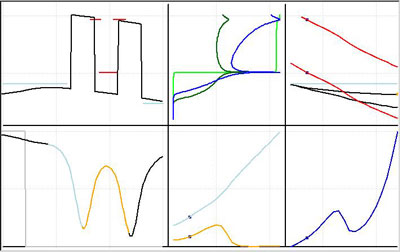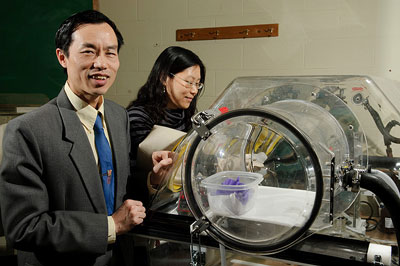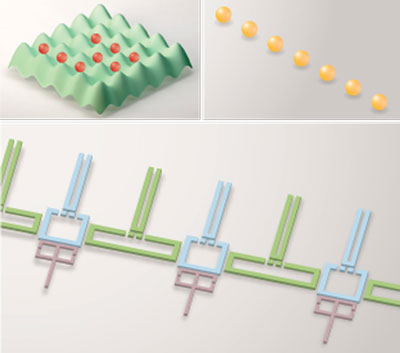 A new version of RTDNEGF (1.3.2) has been recently deployed on the nanoHUB website. RTDNEGF is a simulator for Resonant Tunneling Diodes (RTD) that implements the Non Equilibrium Green Formalism (NEGF) as its principal computational model.
A new version of RTDNEGF (1.3.2) has been recently deployed on the nanoHUB website. RTDNEGF is a simulator for Resonant Tunneling Diodes (RTD) that implements the Non Equilibrium Green Formalism (NEGF) as its principal computational model.
Jan 10th, 2010
Read more
Los Alamos National Laboratory has identified the Top 10 Laboratory science stories of 2009 based on global viewership of online media content and major programmatic milestones.
Jan 9th, 2010
Read more
A strip of paper infused with carbon nanotubes can quickly and inexpensively detect a toxin produced by algae in drinking water.
Jan 8th, 2010
Read more
With ultimate research targets ranging from off-shore wind power and coral reef ecology to quantum physics and nanotechnology, the 12 projects will launch more than $250 million in new laboratory construction projects beginning early this year.
Jan 8th, 2010
Read more
 To overcome the problems associated with metallic implants, many research organizations and commercial companies have tried to develop orthopedic implants that have a bioactive surface to promote cellular adhesion and bony in-growth. Efforts have been made to create a stable fit that more closely resembles the original tissue, thus eliminating the need for additional surgery to repair the damage or gaps.
To overcome the problems associated with metallic implants, many research organizations and commercial companies have tried to develop orthopedic implants that have a bioactive surface to promote cellular adhesion and bony in-growth. Efforts have been made to create a stable fit that more closely resembles the original tissue, thus eliminating the need for additional surgery to repair the damage or gaps.
Jan 8th, 2010
Read more
New experiments on a recently discovered class of iron-based superconductors suggest that the ability of their electrons to conduct electricity without resistance is directly connected with the magnetic properties of those electrons.
Jan 8th, 2010
Read more
The FramingNano project partners and Advisory Board members gathered in Brussels on Monday, 14 December 2009, ahead of the FramingNano International Conference 'A New Governance Framework for Nanotechnologies' on 15 December.
Jan 8th, 2010
Read more
A new discovery by University of Central Florida researchers has revealed a previously unknown mechanism that may drive the early brain function deterioration of Alzheimer's victims, thus opening a new exploratory path in the quest for an Alzheimer's cure.
Jan 8th, 2010
Read more
 Seit 2002 kommen beim Forum Mikroskopietrends jaehrlich Wissenschaftler und Entwickler zur Diskussion aktueller Mikroskopiekonzepte zusammen. Das Forum Mikroskopietrends ist eine etablierte Kontakt- und Diskussions-Plattform der deutschen Mikroskopieszene mit anerkannter hoher inhaltlicher Qualitaet.
Seit 2002 kommen beim Forum Mikroskopietrends jaehrlich Wissenschaftler und Entwickler zur Diskussion aktueller Mikroskopiekonzepte zusammen. Das Forum Mikroskopietrends ist eine etablierte Kontakt- und Diskussions-Plattform der deutschen Mikroskopieszene mit anerkannter hoher inhaltlicher Qualitaet.
Jan 8th, 2010
Read more
Biologists at the University of Freiburg, Germany, around Lecturer Dr. Wolfgang Frank und Professor Dr. Ralf Reski from the Chair Plant Biotechnology have discovered that such micro RNAs also come into direct contact with genes, effectively turning off the genes in the process.
Jan 8th, 2010
Read more
 With an advanced microscopy technique, researchers headed by Frank Winkler of the Ludwig-Maximilians University (LMU) Munich have followed the different stages of metastases formation in real time. In the course of their work, they also found the processes that lead to a 'dead end' for the cancer cells, meaning that no metastases form.
With an advanced microscopy technique, researchers headed by Frank Winkler of the Ludwig-Maximilians University (LMU) Munich have followed the different stages of metastases formation in real time. In the course of their work, they also found the processes that lead to a 'dead end' for the cancer cells, meaning that no metastases form.
Jan 8th, 2010
Read more
The Southampton centre will focus on photonics, the science and application of light using optical fibres to revolutionise the internet and telecommunications. Other centres at the universities of Loughborough and Brunel will concentrate on regenerative medicine and liquid metals.
Jan 8th, 2010
Read more
 Controllable quantum systems that allow us to better understand complex physical processes are now within reach.
Controllable quantum systems that allow us to better understand complex physical processes are now within reach.
Jan 8th, 2010
Read more
The House of Lords Science and Technology Committee today criticises the food industry for failing to be transparent about its research into the uses of nanotechnologies and nanomaterials.
Jan 8th, 2010
Read more
Incorporation of nanomaterials with dimensions of less than 10 nm into functional devices has been hindered by the disparity between their size and the 100 nm feature sizes that can be routinely generated by lithography. Biomolecules offer a bridge between the two size regimes, with sub-10 nm dimensions, synthetic flexibility and a capability for self-recognition.
Jan 7th, 2010
Read more
Aneeve Nanotechnologies LLC has been selected to work in the UCLA on-campus Technology Incubator Program at the California NanoSystems Institute. The startup company will conduct early-stage research for the development of a novel hormone sensor/meter for biomedical applications in the areas of infertility and menopause.
Jan 7th, 2010
Read more
 A new version of RTDNEGF (1.3.2) has been recently deployed on the nanoHUB website. RTDNEGF is a simulator for Resonant Tunneling Diodes (RTD) that implements the Non Equilibrium Green Formalism (NEGF) as its principal computational model.
A new version of RTDNEGF (1.3.2) has been recently deployed on the nanoHUB website. RTDNEGF is a simulator for Resonant Tunneling Diodes (RTD) that implements the Non Equilibrium Green Formalism (NEGF) as its principal computational model.




 Subscribe to our Nanotechnology News feed
Subscribe to our Nanotechnology News feed